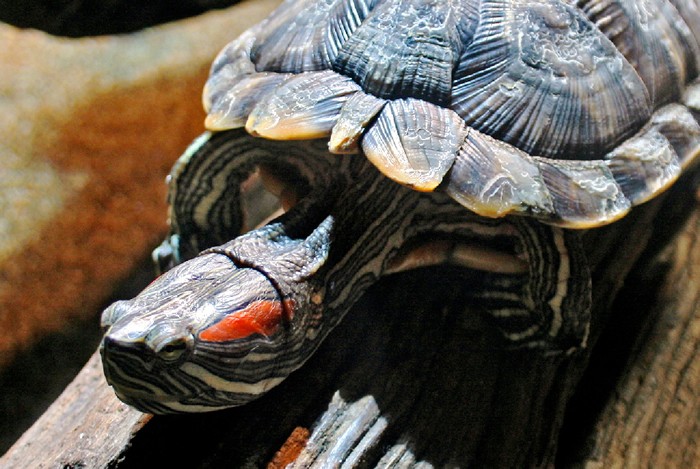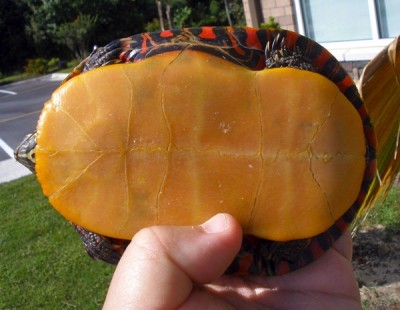Red-Eared Slider (Trachemys scripta)
Natural history
Red-eared sliders are native to the eastern and central United States river valleys. Most pet sliders are captive bred and hatched. Red-eared sliders are hardy and outgoing.
Although pretty and personable as pets, red-eared sliders occupy a niche of dark history in herpetoculture, first as transmitters of Salmonella bacteria to small children, second as an invasive species that have disturbed ecosystems throughout the waterways of the world. The former problem is the result of husbandry and marketing practices of large-scale commercial producers; the latter due to illegal release of unwanted pets.
Taxonomy
Class: Reptilia
Order: Chelonia/Testudines
Family: Emydidae
Genus: Trachemys
Color and Size
Young red-eared sliders are bright green with yellow markings and a red stripe just behind the eyes. Colors dull with age.
Male red-eared sliders are smaller than females, but they have longer tails. Adults typically range from 5-9 inches (13-23 cm) in length, although females may reach 12-13 in (30-33 cm).
Diet
Red-eared sliders are omnivores. Juveniles require a higher proportion of animal protein, while adults consume more plant matter. Generally, young healthy sliders or sick hospitalized sliders do best when fed commercial pelleted foods and then offered snacks for variety. For long-term care of healthy adults, feed more plant material to control calorie intake:
- Dark, leafy greens such as collard, mustard, and dandelion greens make up the bulk (40%-60%) of the adult diet. Mix greens with coarsely chopped vegetables such as carrots, squash, green beans, and broccoli.
- Offer a commercial turtle diet, such as sticks, pellets, or trout chow as 25%-50% of the diet.
- Animal protein sources may include live feeder fish, earthworms, cooked chicken, or earthworms purchased from a reputable supplier.
- Fruit, such as apple, cantaloupe, melon, and berries, can be offered as an occasional treat.
Feed adults once every 2-3 days; juveniles require daily feeding. Feed sliders in the water.
Aquatic turtles are messy eaters and foods can interfere with the filters needed to keep turtle tanks clean. Pet sliders may be fed in a separate tank in which water can be discarded after each meal.
Husbandry
| Temperature | Maintain water temperature between 75-80°F (24-27°C), with the help of a submersible aquarium heater. The basking area should reach between 84-94°F (29-34°C). Fortunately sliders are hardy turtles that can thrive in cooler and warmer environs. |
| Humidity/water | See below |
| Cage size and design |
|
| Cage furniture/supplies |
|
| Social structure | Red-eared sliders are communal and may do best when housed in groups. |
Lifespan
Average lifespan ranges from 15-25 years although sliders can live much, much longer.
The age of sexual maturity depends more on size rather than age. Turtles grow at varied rates depending on the availability and quality of food. Males reach sexual maturity about the time their carapace (upper shell) length reaches 4 inches (10 cm), which tends to be anywhere from 2-5 years. Females become sexually mature about the time the carapace reaches 6-7 in (15-18 cm) in length, which can take up to 5-7 years.
Anatomy/ physiology
- Chelonians possess a tough, horny beak instead of teeth.
- The shell consists of bony plates covered with keratinized shields called scutes. The upper shell is called the “carapace” and the bottom shell is the “plastron”.
- There is a relatively short trachea with complete tracheal rings. The lungs are large and sac-like with many septa. The lungs occupy the upper half of the coelomic cavity, and usually extend along its entire length. Total lung volume changes with head and neck position, and may decrease by 20-30% when the head and neck are drawn inside the shell.
- Turtles have a thin-walled, very distensible, bilobed bladder.
- A single, large, smooth phallus sits on the cloacal floor.
- Males have a longer, thicker tail and a more concave plastron.
Restraint
Sliders are easily held by the shell, however some individuals will scratch with their claws or reach their long necks around and bite the handler. It can be challenging to extend the head and neck even in the weak slider.
Always wash your hands after handling turtles due to the risk of salmenollosis.
Jugular vein (the right vein is often larger than the left)
Brachial artery/distal humeral plexus
Preventive medicine
Regular physical examination
Important medical conditions
Red-eared sliders are very hardy. Problems seen in captivity can include:
-Pneumonia
-Skin and shell infections
**Login to view references**
References
References
Bartlett RD, Bartlett PB, Griswold B, Amphibians, and Invertebrates: An Identification and Care Guide, 2nd ed. Hauppage, NY: Barron’s Educational Series; 2010.
Boyer TH. Aquatic turtle care. ARAV 2(2):13-17, 1992.
De Vosjoli P. Red-Eared Sliders: From the Experts at Adv Viv Sys. AVS. 2002.
Ernst CH, Lovitz, JE. Turtles of the United States and Canada. Johns Hopkins Univ press. 2009.
Jackson DC. Life in a Shell: A Physiologist’s View of a Turtle. Harvard Univ. Press. 2011.
Pollock C. Basic information sheet: Red-eared slider. July 12, 2012. LafeberVet Web site. Available at https://lafeber.com/vet/basic-information-red-eared-slider/

